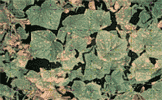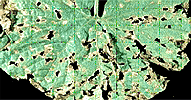Reports on Plant Diseases |
| RPD No. 919 -
Angular Leaf Spot of Cucurbits |
November
1999 |
[ Symptoms
] [ Disease Cycle ] [ Control
]
|
Angular leaf spot of cucurbit crops, caused by the bacterium Pseudomonas
syringae pv. lachrymans, is widespread and particularly damaging in Illinois
after extended and frequent summer rains, especially when temperatures
are between 75 and 82 F (23 to 28 C). The disease is more severe on cucumber,
Zucchini squash, and honeydew melon but it also can infect muskmelon,
cantaloupe, watermelon, other squashes, pumpkins, various gourds, vegetable
marrow, West Indian gherkin, and bryonopsis. Losses in processing cucumbers
can exceed 50 percent in wet seasons where control measures are not practiced.
Symptoms
Small, round to irregular, water-soaked spots appear on infected cucumber
leaves. The spots expand until they are limited by larger veins, which
give the spots an angular appearance. The spots on the upper leaf surfaces
turn whitish gray to brown and die (Figure l). On the lower leaf surfaces,
the lesions are gummy and shiny. As these spots dry they shrink and commonly
tear away from the healthy portions of the leaf, leaving large irregular
holes (Figure 2). Therefore, infected foliage appears ragged and yellowish.
Young, fully expanded leaves are more susceptible than older leaves. Under
humid conditions, water-soaked spots are covered with a white exudate.
The exudate dries to form a thin white crust on or adjacent to the spots
under the leaf surface.
|

Figure 1.
Angular leaf spot of cucumber.
|
|

Figure 2.
Closeup of cucumber leaf infected by angular leaf spot.
|
On squash the brown leaf spots vary in size and are surrounded by a
yellow halo. The tissue next to the halo may be water-soaked, especially
on the lower leaf surfaces following damp weather.
On watermelon the leaf spots begin as small, usually circular, dark
lesions surrounded by a yellow halo. The center of the lesions may be
white. The enlarging spots become angular and can involve entire lobes
or even larger areas of a leaf.
The nearly circular, water-soaked spots on ripening cucumber fruit
are much smaller than those on the foliage (Figure 3). When the infected
tissue dies, the centers of the lesions become chalky white and may
crack open. Infected fruit is frequently invaded by secondary fungi
and bacteria. This fruit breaks down to form a slimy, foul smelling
rot. Lesions may develop after harvest when the fruit is in transit
or storage. Droplets of bacterial ooze frequently appear at infection
sites on leaves, stems, petioles, and fruit in very humid weather. The
droplets dry to form a whitish crust. Fruits infected when they are
young can become deformed and curved.
|
|
Disease Cycle
The Pseudomonas bacterium is a seedborne pathogen. The pathogen can overwinter
in infested crop residues. Upon germination of seed, the cotyledons become
infected. The bacterium multiplies in the intercellular space of leaves
and colonizes leaf surfaces. During warm rainy weather or sprinkler irrigation,
the bacteria are splashed from infected seedlings to the foliage of healthy
plants and later to the fruit. The bacteria are carried from plant to
plant by splashing rain, by insects, on the hands and arms of pickers,
and on farm machinery. Windblown sandy soil containing infested debris
and irrigation water contaminated with the bacterium are effective in
spreading the disease. If bacteria reaches the developing seed, they can
infect the seed coat.
The presence of free moisture on the foliage and fruit is essential for
infection to occur. Infection and disease development are promoted by
water-soaking of leaves which follows extended periods of rainfall, high
relative humidity (95 percent or above), and a combination of warm, moist
soil and cool nights followed by warm days. Two weeks of dry weather will
stop disease development but a high temperature of 98 F (36 C) for 5 days
will not. High nitrogen levels result in more severe disease.
Back to Top
|

Figure 3.
Early symptoms of angular root spot.
|
Control
1. Plant certified, disease-free seed grown in a semiarid area of the western
United States. Seed from infected crops should never be saved. Treatment of
cucurbit seed for 20 minutes with water at 122 F (50 C) containing various acidic
organic chemicals reduces the number of bacteria in the seed but does not entirely
eliminate them.
2. Do not grow cucurbits in the same field or garden area more than once every
3 or 4 years. Rotate with other vegetables, flowers, or small fruits. Avoid
fields that receive run-off water from nearby cucurbit fields.
3. Avoid cultivating, harvesting, or otherwise handling plants when they are
wet. Limit the use of overhead irrigation and excessive levels of nitrogen fertilization.
4. Apply a suggested bactericide (fixed copper) spray in combination with an
organic fungicide starting early in the season before leaf symptoms appear.
The fixed copper and organic fungicide are usually tank-mixed at half the labeled
rates and applied at weekly intervals.
5. Resistance or tolerance to angular leaf spot is available in cucumbers.
Consult current seed catalogs and trade publications for that information.
6. Where feasible, cleanly plow under or collect and burn crop debris immediately
after harvest.
7. Minimize harvest wounds on slicing cucumbers by cutting rather than tearing
the stems from the fruit. Use harvest containers that are smooth and flexible.
8. Control cucumber beetles and other insects by following a regular spray
program.
Information concerning spray programs, suggested cultivars, and fertilizer
use is available at your nearest Extension office and in the Illinois Homeowner's
Guide to Pest Management, which is revised annually.
|



